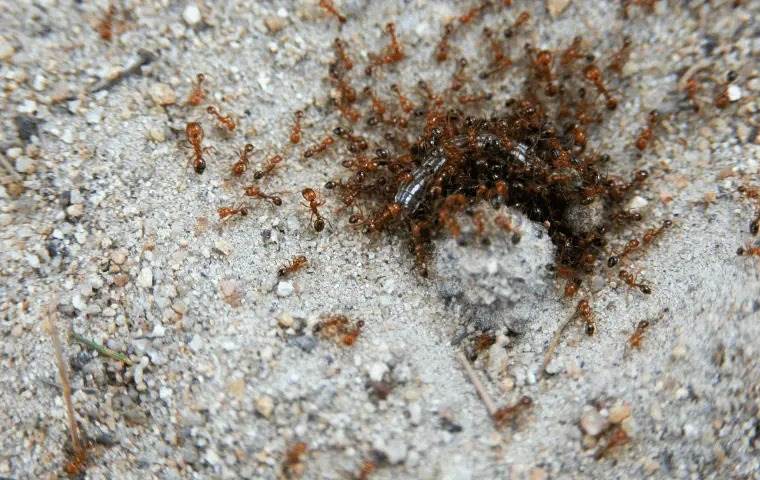
Red Imported Fire Ant Identification in Florida
Identifying Fire Ants in Florida

As anyone who’s ever been bitten by a fire ant can confirm, it’s an experience you’re not likely to forget. The initial sting of the bite is quickly followed by a burning sensation from their venom, hence the name “fire” ant.
Fire ants are a well-known pest in Florida, causing problems for residents, agriculture, and the environment. These invasive insects, originally from South America, have spread rapidly through the state, adapting easily to Florida's climate and soil conditions. Their aggressive behavior, painful stings, and complex colonies present significant challenges to people and wildlife.
By identifying these ants, Florida residents can take steps to prevent infestations and protect their homes and local ecosystems. Ongoing research into fire ant behavior can also shed light on pest control solutions.
Key Takeaways
- Fire ants are an invasive species that threaten Florida's environment and economy.
- Recognizing fire ants can help prevent and control infestations.
- Research into fire ant behavior and control methods helps inform effective long-term management strategies.
Understanding Fire Ants Biology
Fire ants (Solenopsis invicta) are native to South America and known for their aggressive behavior, painful sting, and red-to-dark brown appearance. Adults measure about 1/8 to 1/4 inches (about 2-6mm) in length and have a distinct two-segmented waist and a stinger on the tip of their abdomen.
The bodies of fire ants consist of three major segments: the head, thorax, and gaster (abdomen). They exhibit red or brown coloration and range from about 1/16 to 1/4 inches in length. Key features include:
- Head: A triangular shape with strong mandibles (jaws) and a pair of antennae, which help in navigation and communication.
- Thorax: The middle section where three pairs of legs are attached.
- Gaster: The hindmost section, where the venomous stinger is attached, used for defense and offense against threats.
Fire ants are categorized into various castes:
Their diet includes:
- Protein sources: Insects, small animals
- Carbohydrates: Plant matter, nectar
- Lipids: Seeds, other insects
Origins and Spread
Fire ants were unintentionally introduced to the United States from South America in the 1930s, likely through shipping ports. They have since spread throughout the southeastern United States, including Florida.
The spread of fire ants was facilitated by:
- Their adaptability to various environments.
- Their ability to thrive in disturbed habitats, such as construction sites and agricultural lands.
- A lack of natural predators in the United States.
- Human activity, like the movement of soil and materials, which can transport fire ants and their queens to new locations.
Mound Structures
Unlike other ant species, fire ants build distinctive, dome-like mounds, structured around the queen and made of loose soil, often found in lawns, gardens, and parks. Mound characteristics include:
Impacts of Fire Ant Infestation
Effect on Humans
The painful sting of fire ants often results in redness, swelling, and pustules. It can also cause a burning sensation. Some individuals may have an allergic reaction to the stings, which can lead to life-threatening anaphylactic shock.
Effects on Wildlife
Fire ants can be highly aggressive when their nest is disturbed. Wildlife affected by fire ant infestation include:
- Insects: Fire ants often outcompete native ants and other insect species for food and resources.
- Ground-nesting birds: Eggs, chicks, and adult birds can fall prey to fire ants.
- Reptiles and amphibians: Hatchlings and young reptiles and amphibians in habitats frequented by fire ants often suffer high predation rates.
Effects on Agriculture and Environment
Fire ants tend to be attracted to agricultural lands due to ample food sources. They damage crops by feeding on seeds and seedlings, and sting and attack farm animals. Fire ant stings can also affect farmworkers and their productivity.
On the environmental side, they can reduce plant diversity by feeding on seeds and plants, alter soil composition, and outcompete native ants which disturbs the ecological balance within Florida's habitats.
Fire Ant Control
Prevention Tips
By incorporating the following prevention tips, homeowners can reduce the likelihood of a fire ant infestation:
- Remove attractants: Eliminate food sources by keeping outdoor trash and compost bins tightly sealed and maintaining clean feeding areas for pets.
- Limit access: Regularly inspect homes and buildings for potential entry points such as cracks in the foundation or gaps around windows, doors, and utility wires. Seal these openings to prevent fire ants from gaining access.
- Landscape maintenance: Routinely mow the lawn and trim shrubbery, as fire ants prefer overgrown vegetation for nesting. Avoid using landscape elements such as stumps and rocks that may provide an ideal nesting environment.
- Monitor for infestations: Regularly inspect your property for signs of fire ant mounds, especially near sidewalks, patios, and along bodies of water.
Treatment Options
Two primary approaches to fire ant infestation are recommended.
Individual Mound Treatments
Treat individual fire ant mounds with one of three options:
- Drenching the mound with an approved insecticide solution, ensuring it penetrates deeply to reach the queen.
- Sprinkling granular insecticide products on and around the mound, then activating with water.
- Applying a thin layer of insecticidal dust to the mounds surface. Worker ants will transport this poison back to the colony.
Pros: Quick results. Targeted approach.
Cons: Less effective on large infestations. Requires locating all mounds.
Broadcast Bait Applications
Treat with bait products by:
- Choosing a product approved for fire ant control.
- Applying baits according to the product label's instructions.
- Following up with additional applications if necessary.
Pros: Effective for large infestations. Requires minimal mound locating.
Cons: Slower results. Possible non-target impacts.

Why Choose Native Pest Management?
We Exceed Customer Expectations
-
Pet Friendly & Environmentally ConsciousNative Pest Management applies our pest control products with the safety of your family and pets in mind! We also offer eco-friendly pest control to protect your family and the planet.
-
Local Service ProfessionalsSince 2015, we have served communities in West Palm Beach and all throughout South Florida. Our team is fully licensed, insured, and vetted.
-
On TimeOur team will not only arrive on time, but they’ll also go above and beyond when providing service. It’s what makes us one of the top rated pest control companies in Florida! We strive for complete customer satisfaction every time.
-
Get a 100% Free Estimate
Whether you currently have pests in your home or simply want to start professional pest prevention, take the first step to a pest-free life, and contact us today for your free pet-friendly pest control quote.
-
“Warren took his time with the servicing and was very knowledgeable! Exceptional customer service. I will be requesting him each time.”- Montiea Singletary
-
“Excellent service by Chino from Native Pest Management. Chino went above and beyond to make sure we understood everything about the service and kept us very informed during the process.”- Brand Gonzalez
-
“Truly professionals at what they do. very respectful very knowledgeable and great attitude.”- Jorge Acosta
-
“I called and spoke to the manager, who was polite and courteous, and even though it cost them money to come back out and spray, they did not charge me again, and I was very thankful.”- S. Williams
-
“Dale is the absolute best in the business of pests! My sister and I personally ask for him every single time because he always goes above and beyond.”- Zariah Graham
-
“The technician was very professional. He explained things thoroughly and put me at ease with what was about to happen in my home.”- Anthony Diaz
-
“Native pest management always exceeds my expectations! The people who answer the phone are so nice and accommodating and make scheduling a breeze! The techs are always so nice and do a great job.”- Michelle Cato
-
“Extremely impressed with the technicians I met today. Tony and Jamie. Very thorough and customer oriented. I am expecting great things for my trees and plants.”- Curt Kredo

Native Pest Management's Blog
Want all the latest news or updates? Browse through our blog to read our most recent posts and featured articles.







